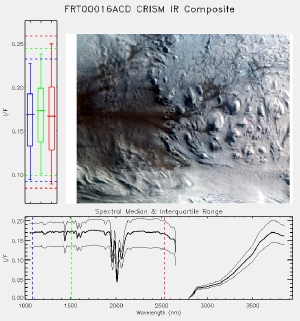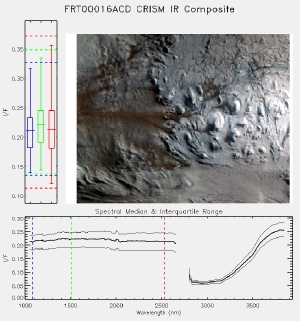TRR3 IR FALSE COLOR COMPOSITE

CORRECTED TRR3 IR FALSE COLOR COMPOSITE 
|
ACCESS TO MRO DATA IN THE PDS
The following links provide direct access to the PDS archive of calibrated CRISM data for this observation if the data have already been archived, as well as to CTX or HiRISE images coordinated with it.
ACCESS TO PROTOTYPE TRR3 CRISM DATA
These prototype TRR3 data products are being made available prior to PDS release to support MSL landing site studies. Permission for use is for that purpose.
PDS labels for TRR3 products are under development. The labels here are “PDS-compliant” labels from radiance images used to calculate I/F, and some of the label information is mismatched (e.g., units). However these labels are adequate to support ingestion of TRR3s into CAT.
ABOUT THE COMPOSITE IMAGES
The three-panel composite images are composed of: a false color RGB rendering of the CRISM targeted observation central scan data with a 0.5% linear stretch applied to each displayed band; a spectral plot showing the median scene spectrum, and interquartile spectral envelope, and the wavelengths of the bands used in the RGB rendering (dashed vertical lines). Boxplots showing the data distribution and stretch limits for the bands used in the RGB rendering.
The upper composite shows the content of the corresponding CRISM prototype TRR3 I/F targeted observation central scan image cube. The lower (corrected) composite shows the content of the image cube after a series of corrections have been applied to the data. These corrections include: a simple photometric correction (division by the cosine of the incidence angle); a simple atmospheric correction (IR data only – division by a scaled empirical atmospheric transmission spectrum); the empirical normalization of the data to a CRISM gimbal angle zero (minimum emission angle) observing geometry; and the empirical correction of a radiometric calibration residual related to spectral smile. The corrected image cubes are used in the subsequent calculation of spectral summary parameters and browse products.
Downloads:
|

